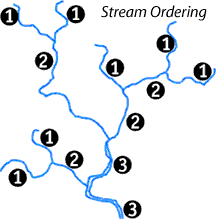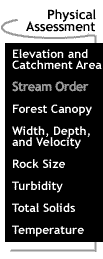
Water
Quality Assessment: Physical: Stream Order
Stream order is
a measure of the relative size of streams. The smallest tributaries
are referred to as first-order streams, while the largest river in the
world, the Amazon, is a twelfth-order waterway. First- through third-order
streams are called headwater streams.
Over 80% of the total length of Earth's waterways are headwater streams.
Streams classified as fourth- through sixth-order are considered medium
streams. A stream that is seventh-order or larger constitutes a river.
When diagramming stream order, scientists begin by identifying the first-order streams in a watershed. First-order streams are perennial streams--streams that carry water throughout the year--that have no permanently flowing tributaries. This means no other streams "feed" them.
 Once
the first order streams are identified, scientists look for intersections
between streams. When two first-order streams come together, they form
a second-order stream. When two second-order streams come together, they
form a third-order stream. And so on. However, if a first-order stream
joins a second-order stream, the latter remains a second-order stream.
It is not until one stream combines with another stream of the same order
that the resulting stream increases by an order of magnitude. See the
diagram to the right.
Once
the first order streams are identified, scientists look for intersections
between streams. When two first-order streams come together, they form
a second-order stream. When two second-order streams come together, they
form a third-order stream. And so on. However, if a first-order stream
joins a second-order stream, the latter remains a second-order stream.
It is not until one stream combines with another stream of the same order
that the resulting stream increases by an order of magnitude. See the
diagram to the right.
Examining the stream network is important in determining study sites. It is best to sample a stream above and below any point at which a tributary enters it, as well as in the tributary itself. The result is 3 sample sites at each intersection of two streams. This is done so that one can narrow down the location of any potential pollutants.
Stream order is also an important part of the River Continuum Concept. The River Continuum Concept is a model used to determine the biotic community expected in a stream based on the size of the stream itself. As water travels from headwater streams toward the mouths of mighty rivers, the width, depth, and velocity of the waterways gradually increase. The amount of water they discharge also increases. These physical characteristics dictate the types of aquatic organisms that can inhabit a stream.
Overview ..|.. Biological Assessment ..|.. Chemical Assessment ..|.. Physical Assessment.
Elevation
and Catchment Area / Stream Order / Forest
Canopy / Width, Depth, and Velocity
/ Rock Size / Turbidity
/ Total Solids / Temperature Home
..|..
Teacher Pages
..|..
Modules
& Activities
Glossary .|.
Related Links
.|..
References
..|..
PBL Model
.|
HTML code by Chris Kreger
Maintained by ETE Team
Last updated November 10, 2004
Some images © 2004 www.clipart.com
Privacy Statement and Copyright © 1997-2004 by Wheeling Jesuit University/NASA-supported Classroom of the Future. All rights reserved.
Center for Educational Technologies, Circuit Board/Apple graphic logo, and COTF Classroom of the Future logo are registered trademarks of Wheeling Jesuit University.
